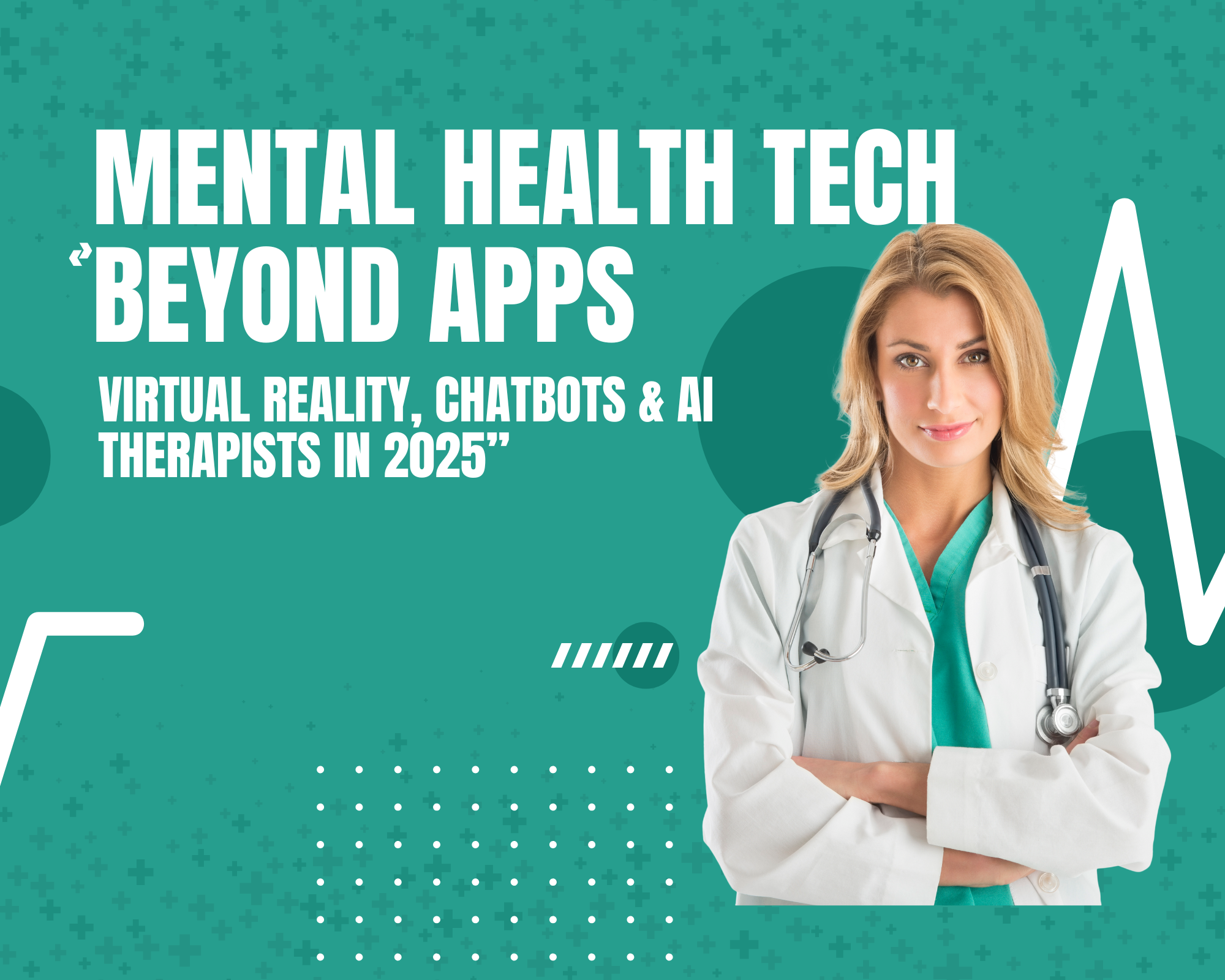You might know how big digital mental health solutions are getting. Technology is moving us past just apps to new, exciting ways to help.
Virtual reality therapy and AI-powered chatbots are becoming key players in mental health technology. They open up fresh paths for support and treatment.
Key Takeaways
- Innovative solutions like VR therapy and AI chatbots are changing the mental health tech landscape.
- Digital mental health is becoming increasingly important.
- Technological advancements are offering new support and treatment options.
- The future of mental health support is likely to involve more VR and AI-driven solutions.
- Embracing these changes can lead to better mental health outcomes.

Looking ahead to 2025, it’s clear that mental health support will rely on these tech leaps. You’ll see more of VR therapy and AI in mental health care.
The Digital Transformation of Mental Health Support
The way we get mental health care is changing. It’s becoming more accessible and tailored to each person. With new technology, how we use mental health resources is evolving.
From Self-Help Books to Smartphone Apps
Now, we use smartphone apps instead of old self-help books. This change lets us get help anytime, anywhere. Digital mental health support is growing, offering tools and services just for you.
As a response, regulations around different mental healthcare services are changing, and mental health organizations are receiving more funding to support digital solutions to make mental healthcare more accessible and improve operations for mental health services organizations.
The Limitations of First-Generation Mental Health Apps
Early mental health apps were a start, but they had big flaws. You might have seen these problems yourself, like:
- Lack of personalization
- Limited engagement strategies
- Insufficient feedback mechanisms
Engagement Issues and Dropout Rates
Many mental health apps face a big problem: not enough people stick with them. This shows we need apps that are more interactive and personal.
The Need for More Personalized Experiences
Apps need to offer experiences that fit you better. This could mean using AI to understand your needs and give you the right help.

Knowing these issues helps us find better digital mental health tools. We can choose apps that really support our mental health journey.
The Current State of Mental Health Technology in 2025
The world of mental health tech is changing fast. New tools are coming out to help more people. These digital helpers aim to make mental health care better and easier to get.
Today’s Digital Mental Health Landscape
The digital world of mental health is full of options. You can find everything from mobile apps to advanced tech like virtual reality (VR) and artificial intelligence (AI). These tools are being used in many ways, from finding problems to helping with treatments.

The Growing Demand for More Immersive Solutions
People want deeper, more real mental health help. This is why there’s a push for more immersive tech. For example, VR is being looked at to create real-life-like settings for therapy.
How the Pandemic Accelerated Digital Mental Health Adoption
The COVID-19 pandemic made digital mental health tools more popular. When face-to-face help wasn’t possible, online support became key. This need led to more tech and ways to help people online.
| Technology | Application in Mental Health | Benefits |
|---|---|---|
| Virtual Reality (VR) | Exposure therapy, stress management | Immersive, controlled environments for therapy |
| Artificial Intelligence (AI) | Chatbots, personalized therapy plans | 24/7 support, tailored therapeutic approaches |
| Mobile Apps | Mood tracking, cognitive behavioral therapy | Accessibility, convenience, and anonymity |
Virtual Reality: Reimagining Therapeutic Environments
Imagine therapy sessions in immersive, controlled worlds. Welcome to the future of mental health care with VR. Virtual reality is changing therapy, offering experiences beyond traditional methods. You’re about to see how VR is reshaping therapy.
How VR Exposure Therapy Works in Practice
VR exposure therapy slowly introduces you to simulated environments that cause anxiety or fear. It helps you get used to these stimuli. This method is promising for treating PTSD and specific phobias. The key advantage is the ability to control the environment, ensuring a safe and effective therapy.
Case Studies: Treating Anxiety, PTSD, and Phobias
Many studies show VR therapy’s success in treating anxiety disorders, PTSD, and phobias. For example, a study in the Journal of Clinical Psychology found VR therapy greatly reduced PTSD symptoms in veterans. The immersive nature of VR makes treatment more engaging and effective.
The Neuroscience Behind VR’s Effectiveness
VR therapy’s success comes from its impact on the brain. The immersive experience triggers a strong brain response, making therapy more memorable. Let’s explore the neuroscience behind it.
Presence and Immersion Effects on the Brain
The sense of presence and immersion in VR affects the brain’s emotional processing. Research shows this can increase emotional arousal, which helps in exposure therapy. The brain’s response is more pronounced due to VR’s realistic experience.
Creating Safe Spaces for Emotional Processing
VR therapy’s big advantage is creating safe spaces for emotional processing. Therapists can control the environment to ensure you feel secure while facing challenges. Dr. Sarah Jones, a leading VR therapy researcher, says,
“VR provides a unique opportunity for patients to confront their fears in a controlled and safe environment.”
By using VR technology, therapists can offer more effective treatments for various mental health conditions. As VR evolves, we’ll see more innovative uses in mental health therapy.
AI-Powered Chatbots: Your 24/7 Mental Health Companion
AI-powered chatbots are key in today’s mental health support. They offer help 24/7. These chatbots help people manage their mental health better.
Beyond Scripted Responses: Natural Language Processing Advances
Natural language processing (NLP) has improved chatbots. They can now have more personal and nuanced talks. This lets them understand and respond to complex emotions, offering empathy and support.
The landscape of healthcare is undergoing a digital revolution, and AI (Artificial Intelligence) is at the forefront of this transformation. One of the most exciting applications of AI in healthcare is the rise of chatbots — virtual assistants that can significantly improve patient communication and support.
These chatbots are no longer clunky, pre-programmed robots of science fiction. Today’s AI-powered chatbots leverage natural language processing (NLP) and machine learning to understand patient queries, respond with accurate information, and even provide basic medical guidance.
Real-Time Mood Tracking and Crisis Intervention
AI chatbots can track your mood in real-time. They offer help during crises. This is especially helpful for those with severe mental health issues, as it provides quick support.
Privacy Concerns and Ethical Considerations
AI chatbots have many benefits but also raise privacy and ethical questions. It’s important to address these to ensure chatbots are used safely and effectively in mental health care.
Data Security in Mental Health AI
Keeping mental health data safe is crucial. Developers must use strong data protection to keep user info secure.
Transparency About AI Limitations
It’s key to be open about what AI chatbots can and can’t do. Users need to know their limits to use them correctly.
| Feature | Benefit | Limitation |
|---|---|---|
| Natural Language Processing | Personalized interactions | Understanding complex nuances |
| Real-Time Mood Tracking | Timely interventions | Dependence on user input |
| Data Security | Protecting user data | Risk of data breaches |
Digital Therapeutics: FDA-Approved Mental Health Treatments
Digital therapeutics are a new area in mental health care. They offer FDA-approved treatments that are changing lives. These treatments are tested and approved by regulatory bodies, ensuring they are safe and work well.
The Difference Between Apps and Prescribed Digital Therapeutics
Many mental health apps are available, but not all are the same. Digital therapeutics are made to treat medical conditions and are backed by clinical evidence. They are prescribed by doctors and often have a structured treatment plan.
General mental health apps may offer wellness tools or self-help strategies. But they don’t have the clinical validation of digital therapeutics.
Current and Upcoming FDA-Approved Mental Health Technologies
Several digital therapeutics have already gotten FDA approval. They treat conditions like substance abuse, depression, and anxiety disorders. For example, reSET and reSET-O are FDA-cleared for substance use disorder and opioid use disorder, respectively.
As research keeps moving forward, we can expect more digital therapeutics to be approved. This will give more treatment options for various mental health conditions.
Insurance Coverage and Accessibility Issues
One big challenge for digital therapeutics is insurance coverage. While some are covered, others are not. This makes it hard for patients who could benefit from these treatments to access them.
There are efforts to improve coverage and make digital therapeutics more accessible. This way, these innovative treatments can help more people.
AI Therapists: The Future of Personalized Mental Health Care
AI therapists are changing mental health care by offering tailored support. They understand and respond to human emotions in a unique way. This is more than just processing information.
How AI Analyzes Speech, Text, and Facial Expressions
AI therapists analyze speech, text, and facial expressions to understand a user’s mental state. This multi-modal analysis gives a deeper understanding of what a user needs.
For example, AI can spot subtle changes in voice tone or language patterns that show a change in emotions. This allows AI therapists to adjust their responses for better support.
Adaptive Learning: How AI Therapists Evolve With You
AI therapists can adapt and learn from interactions. They use machine learning algorithms to get to know a user’s preferences and responses over time.
- Personalized coping strategies based on user feedback
- Adjustments in therapy techniques to better suit the user
- Continuous improvement in the AI’s ability to empathize and respond
The Human-AI Collaboration in Therapy Settings
AI therapists are not meant to replace human therapists but to enhance their work. AI handles routine or initial assessments, allowing human therapists to focus on complex cases.
When AI Flags Issues for Human Therapists
When AI detects significant distress or complex issues, it alerts human therapists. This ensures users get the right care.
Augmenting Rather Than Replacing Human Connection
The goal of AI therapists is to improve the therapeutic experience, not replace human connection. AI and human therapists work together to offer a more supportive environment.
| Benefits of AI Therapists | Role of Human Therapists |
|---|---|
| 24/7 Support and Accessibility | Complex Case Management |
| Personalized Therapy Plans | Emotional Support and Empathy |
| Data Analysis for Insights | Strategic Therapy Planning |
As AI technology advances, AI therapists will have a big impact on mental health care. By using this technology, we can make mental health support more accessible and personalized.
Biofeedback and Neurofeedback Technologies
Wearable devices and brain-computer interfaces are changing mental health care. They let you see how your body and brain react, helping you manage your emotions better.
Wearable Devices That Monitor Your Mental State
Wearable tech with biofeedback tracks your heart rate, skin conductance, and body temperature. It shows your mental state in real-time. For example, it might tell you when you’re stressed by your heart rate or sweat.
Brain-Computer Interfaces for Mental Health Applications
Brain-computer interfaces (BCIs) are new tech that lets your brain talk to devices. They read your brain signals, giving you insights into your feelings. This tech could change mental health care by making treatments more precise and personal.
Using Your Body’s Signals to Improve Emotional Regulation
Biofeedback and neurofeedback use your body’s signals to help you control your emotions. They help you learn to manage stress, anxiety, or other mental health issues. For instance, neurofeedback might reward calm brain activity, helping you relax.
These advanced technologies help you understand your mental and physical states better. This leads to better emotional health.
Mental Health in the Metaverse: Social Connection and Support
The metaverse is more than a virtual world. It’s a place for mental health support, offering new ways to connect and heal. As you explore, you’ll find new methods to tackle mental health issues.
Virtual Support Groups and Communities
Virtual support groups in the metaverse let you connect with others who understand you. They provide a safe space for sharing and support.In addition to its applications in entertainment, education, and mental health, the industrial metaverse has emerged as one of the most developed and rapidly growing sectors of the metaverse. This sector is focused on leveraging the metaverse to optimize industrial operations, enhance product design, and improve manufacturing processes. For instance, industries such as automotive, construction, and healthcare have begun integrating VR, AR, and MR technologies into their workflows.
Avatar-Based Therapy Sessions
Avatar-based therapy is a unique way to support mental health. It lets you express yourself through an avatar, leading to deeper healing.
Creating Safe Spaces in Virtual Worlds
Creating safe spaces in the metaverse is key for mental health support. These areas are designed to be welcoming and secure, helping you open up in therapy.
Moderation and Safety Protocols
Virtual spaces have strong moderation and safety rules. These protect you from harm, ensuring a supportive environment.
Identity and Self-Expression in Virtual Mental Health Spaces
The metaverse lets you explore different identities and self-expression. This can be very empowering for mental health, offering new views on well-being.
As the metaverse grows, mental health support will likely get better. You’ll have more tools and resources to manage your mental health.
Accessibility and Inclusion in Mental Health Technology
Mental health tech is getting better, but it must be for everyone. The digital world in mental health can help millions. But, it needs to be made for all.
Bridging the Digital Divide
The digital divide is when some people can’t use modern tech. Mental health tech must be easy for everyone to use. It should work with tools for people with disabilities.
Culturally Responsive AI and VR Experiences
It’s important for mental health tech to fit different cultures. AI and VR should understand and respect each person’s background. This way, they can offer support that really works.
Making Advanced Mental Health Tech Affordable
VR therapy and other advanced tech can be pricey. But, there are ways to make them cheaper.
Subscription Models vs. Insurance Coverage
Some services offer subscriptions to lower costs. Insurance is also starting to cover digital mental health services.
Community Access Programs
Community programs help make tech affordable. They offer free or cheap access to mental health tools.
Navigating Your Personal Mental Health Tech Journey
Your mental health journey is unique, and so should be your tech approach. It’s key to make choices that fit your needs in the vast mental health tech world.The review also discusses future directions, stressing the need for technological advancements, better biomarkers, and AI-driven interventions. Lastly, the review calls for more longitudinal studies and clinical trials to validate the effectiveness of metaverse applications in mental health care.
How to Integrate Digital Tools into Your Mental Health Routine
First, figure out what you need for your mental health. Think about how digital tools can help your current routine. For example, you might start your day with meditation using apps like Calm or Headspace.
When to Use Technology vs. When to Seek Human Support
Technology offers quick support, but sometimes, you need a real person. Know when you need human help, like in a crisis or for personal advice.
Questions to Ask Before Trying New Mental Health Tech
Before trying new tech, ask yourself these questions:
- Is there clinical evidence supporting its effectiveness?
- How does the technology protect your data?
Evidence Base and Clinical Validation
Choose tech that’s been proven to work. Look for things like FDA approval, which shows it’s effective.
Data Privacy and Ownership Policies
Know how your data is used and kept safe. A clear privacy policy is important.
| Feature | Ideal Characteristics | Example |
|---|---|---|
| Clinical Validation | FDA-approved or evidence-based | Digital therapeutics like reSET for substance abuse |
| Data Privacy | Transparent, user-centric policies | Apps that clearly outline data usage |
Conclusion: Your Mental Health Toolkit in 2025
Looking ahead, technology will be key in mental health support. Your mental health toolkit in 2025 will be more varied than ever. Innovations like virtual reality therapy, AI chatbots, and personalized AI therapists will be easier to find.
The future of digital mental health goes beyond apps. It’s about creating immersive, supportive spaces that meet your specific needs. By using these advanced tools, you can actively manage your well-being.
Today, you have more options than ever to deal with stress and anxiety. Whether you want to add to traditional therapy or try new methods, the choices are better and more tailored. As you move through your mental health journey, think about how these technologies can help you live a healthier, more balanced life.
FAQ
What is the difference between mental health apps and digital therapeutics?
Digital therapeutics are FDA-approved treatments after rigorous trials. Mental health apps are not FDA-approved and may lack scientific backing.
How do AI-powered chatbots work in mental health support?
AI chatbots use natural language to understand and answer user questions. They offer mood tracking and crisis help while keeping data safe and transparent about their limits.
What is virtual reality exposure therapy, and how does it work?
Virtual reality exposure therapy uses VR to face fears in a safe space. It helps users get comfortable with scary stimuli, backed by neuroscience.
Are AI therapists a replacement for human therapists?
No, AI therapists are meant to enhance human connection, not replace it. They analyze speech and expressions to work with human therapists for personalized care.
How can I ensure my data is secure when using mental health tech?
Look for tech with strong data security, like encryption. Also, check data ownership policies. Know the risks and benefits of sharing your data.




